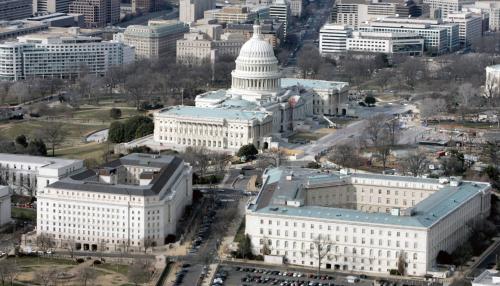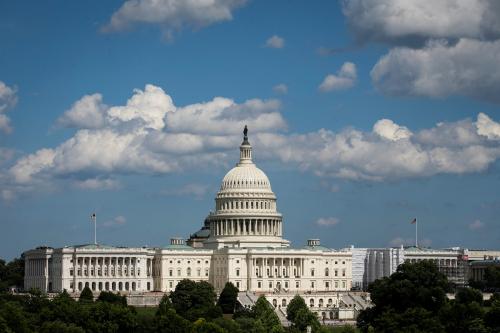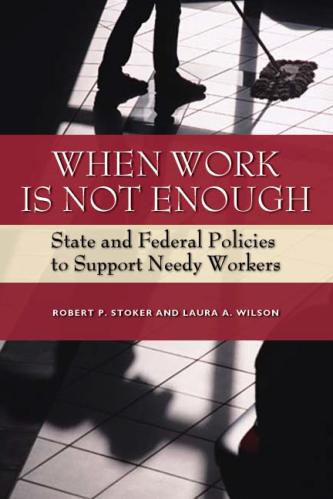The first weeks of the 116th Congress have seen a flurry of budget-related activity, including the re-opening of parts of the federal government after a record 35-day partial shutdown and the passage of a large, omnibus spending bill funding those agencies through the end of September. While Congress’s attention has started to turn to other items—such as the national emergency declared by President Trump and oversight of the executive branch—there’s plenty more budget excitement ahead in 2019.
The start of the 116th Congress brought a change in majority control of the House, and with it, a shift from unified to divided partisan control of government in Washington. This particular flavor of divided government—the House controlled by one party and the Senate and the White House held by the other—was last seen between 2011 and 2015, when Democrats held the White House and the Senate and Republicans controlled the House. As political scientist Frances Lee has written, this kind of fragmented control can lead the president’s party to pursue legislative achievements that make the executive appear effective, while the out-party is more motivated to focus on messaging and to draw contrasts with the president. Indeed, we’ve seen House Democrats adopt a messaging-focused strategy early on in the new Congress, scheduling votes on bills dealing with topics like gun control.
Because of its “must pass” nature, fiscal policy can become a particularly high-stakes arena for these kinds of partisan goals to be pursued during divided government. Legislation passed during the last such period—the Budget Control Act (BCA) of 2011—sets up one of several fiscal policy challenges Congress will have to resolve this year. The BCA implemented ten years of spending caps for the discretionary budget. It included separate limits for defense and non-defense spending, to be enforced by automatic, across-the-board spending cuts (known as “sequestration”) if Congress failed to abide by the caps. Since their enactment, however, Congress has repeatedly—in 2013, 2015, and 2018—chosen to raise the ceiling on spending in two-year increments, with roughly equally sized increases on the defense and non-defense sides of the budget. The most recent of these deals expires at the end of September 2019, which would, absent any other action, lead to spending cuts of roughly 10 percent.
The Trump administration’s opening position on the negotiations over the caps involves maintaining these current spending limits. But the president will also seek an increase in what’s known as Overseas Contingency Operations (OCO) funding to make up for the cuts to the base defense budget. OCO funds—meant to be spent “in support for the broad U.S. government response to the 9/11 attacks and for other related international affairs activities”—are not subject to the BCA caps, making their use an attractive maneuver to grow the defense side of the budget without having to negotiate with Democrats about whether to also increase non-defense spending. Notably, White House acting Chief of Staff Mick Mulvaney was a major opponent of using OCO when he was a member of Congress. During his confirmation hearings to become the Director of the Office of Management and Budget in 2017, he said he “look[ed] forward to having an opportunity to explain to the President why I think it is not a good way to spend American taxpayer dollars.” His apparent change of heart is an excellent illustration of the old lesson that “where you stand depends on where you sit.”
The likelihood of the White House convincing Congress to go along with this proposal are slim. Given their success at insisting on increases to the non-defense caps under unified Republican control in 2017 and 2018, Democrats are unlikely to see a reason to back down when they have more power in Congress in the form of a House majority. Even the ranking Republican on the House Armed Services Committee, Rep. Mack Thornberry (R-Tex.), referred to the plan as “ridiculous, if that’s what they do.”
But the longer Congress goes without reaching a deal on the spending caps, the more difficult it will be for the House and Senate to make meaningful progress on the 12 regular appropriations bills the two chambers are supposed to complete before October 1. After all, it’s hard to divide up a pie when you don’t necessarily know how much bigger (or smaller) this year’s pie will be compared to last year’s. Delays in the appropriations process also hurt federal operations. Short-term spending measures that are used to bridge gaps when bills are unfinished often limit the ability of agencies to start new projects, and once a final deal is reached, agencies sometimes must rush to spend the funds in a shorter period of time.
Even with a caps agreement in place, moreover, the appropriations process may meet some hurdles of its own in divided government. Before the drama of the shutdown in December and January, Congress actually managed a relatively smooth—at least by recent standards—appropriations process in 2018. Central to this was not just the fact that a caps deal was already in place, but also a decision by the leaders of the Senate Appropriations Committee to limit the number of controversial policy provisions, or riders, that were attached to spending measures in the chamber. Senior appropriators could attempt a similar effort this year. But Democrats, especially in the House, may see spending bills as their best tool to limit various Trump administration activities. Even if this dispute is resolved in favor of cleaner bills, any protracted disagreement also has the potential to slow down the overall process.
Also looming for 2019—perhaps as part of the same deal on the spending limits—is the need to address the debt limit, which was last suspended as part of the 2018 legislation that also raised the BCA caps. An analysis from the Bipartisan Policy Center suggests that the Treasury Department will be able to delay the need for action until at least mid-summer, but Congress will need to the tackle the issue at some point this year. Recent debates over the major increases to the debt limit—including those under divided government in 2011, 2014, and 2015, and under unified Republican control in 2018—have all featured demands from some Republicans, especially in the House, that any increase be accompanied by spending cuts.
With Democrats in control of the lower chamber, however, the dynamics shift somewhat; Speaker of the House Nancy Pelosi (D-Calif.) is likely to have an easier time keeping her members on board with a “clean” increase than her Republican predecessors. The biggest potential wild card in a potential debt ceiling fight, then, becomes President Trump. Would he attempt to demand concessions of some kind in exchange for signing a debt limit increase? Recent reporting indicates that the White House believes a caps deal is a bigger source of leverage than the debt limit, but also there may be disagreement within the administration about the strategy going forward.
One thing we’re quite unlikely to see this year is a budget reconciliation bill. The last reconciliation bill adopted by a divided Congress was in 1986, when Democrats had a majority in the House and Republicans controlled the Senate and the White House. (Notably, reconciliation bills in the mid-1980s tended to deal with a wider range of subjects than their recent counterparts, creating a bigger set of potential deals that could be cut.) Why is reconciliation—which allows certain budget-related measures to move through the Senate without the possibility of a filibuster—so unlikely? First, it requires the adoption of a budget resolution by both chambers as the initial step in the process. Increasingly, budget resolutions have become a statement of a party’s priorities and don’t generally attract bipartisan support; two chambers controlled by opposite parties aren’t likely to come to an agreement on one. Second, even if Congress did unexpectedly adopt a budget resolution, reconciliation simply isn’t an attractive tool when the chambers are controlled by different parties.
With these and other budget items—including a potential debate over President Trump’s likely request to reallocate certain funds to build a barrier along the southwestern border—likely to arise over the course of the year, the budget process will be an important arena to watch in Congress.










Commentary
How does a divided government impact the congressional budget process?
February 28, 2019